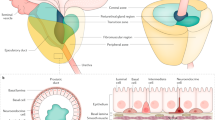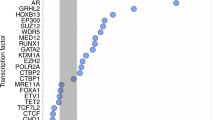Abstract
Overexpression of amplified genes is often associated with the acquisition of resistance to cancer therapeutic agents in vitro. We have identified a similar molecular mechanism in vivo for endocrine treatment failure in human prostate cancer which involves amplification of the androgen receptor (AR) gene. Comparative genomic hybridization shows that amplification of the Xq11–q13 region (the location), is common in tumours recurring during androgen deprivation therapy. We found high–level AR amplification in seven of 23 (30%) recurrent tumours, but in none of the specimens taken from the same patients prior to therapy. Our results suggest that AR amplification emerges during androgen deprivation therapy by facilitating tumour cell growth in low androgen concentrations.
This is a preview of subscription content, access via your institution
Access options
Subscribe to this journal
Receive 12 print issues and online access
We are sorry, but there is no personal subscription option available for your country.
Buy this article
- Purchase on SpringerLink
- Instant access to full article PDF
Prices may be subject to local taxes which are calculated during checkout
Similar content being viewed by others
References
Boring, C.C., Squires, T.S. & Tong, T. Cancer Statistics, 1993 CA. Cancer J. Clin. 43, 7–26 (1993).
Gittes, R.F. Carcinoma of the prostate. New Engl. J. Med. 324, 236–245 (1991).
Stearn, M.E. & McGarvey, T. Biology of disease. Prostate cancer: therapeutics, diagnostic, and basic studies. Lab. Invest. 67, 540–552 (1992).
Berges, R.R., Furuya, Y., Remington, L., English, H.F., Jacks, T. .& Isaacs, J.T. Cell proliferation, DNA repair, and p53 function are not required for programmed death of prostatic glandular cells induced by androgen ablation. Proc. natn. Acad. Sci. U.S.A. 90, 8910–8914 (1993).
Labrie, F., Belanger, A., Dupont, A., Luu-The, V., Simard, J. & Labrie, C. Science behind total androgen blockade: from gene to combination therapy. Clin. Invest. Med. 16, 475–492 (1993).
Culig, Z. et al. Mutant androgen receptor detected in an advanced-stage prostatic carcinoma is activated by adrenal androgens and progesterone. Molec. Endocrinol. 7, 1541–1550 (1993).
Schoenberg, M.P. et al. Microsatelllte mutation (CAG24–18) in the androgen receptor gene In human prostate cancer. Biochem. Biophys. Res. Comm. 198, 74–80 (1994).
Veldscholte, J. et al. A mutation in the ligand binding domain of the androgen receptor of human LNCaP cells affects steroid binding characteristics and response to anti-androgens. Biochem. Biophys. Res. Commun. 173, 534–540 (1990).
Thompson, T.C. Growth factors and oncogenes in prostate cancer. Cancer Cells 2, 345–354 (1990).
Kallioniemi, A. et al. Comparative genomic hybridization for molecular cytogenetic analysis of solid tumours. Science 258, 818–821 (1992).
Kallioniemi, O.-P. et al. Optimizing comparative genomic hybridization for analysis of DNA sequence copy number changes in solid tumours. Genes Chrom. Cancer 10, 231–243 (1994).
Lafreniere, R.G. et al. Physical mapping of 60 DNA markers in the p21.1–21.3 region of the human X chromosome. Genomics 11, 352–363 (1991).
Gaddipati, J.P., McLeod, D.G. & Heidenberg, H.B. Frequent detection of codon 877 mutation in the androgen receptor gene in advanced prostate cancers. Cancer Res. 54, 2861–2864 (1994).
Kellens, R.E. Gene amplificatlon in mammalian cells. A comprehensive guide. (Marcel Dekker, Inc., New York, 1993).
Nowell, P.C. Mechanisms of tumour progression. Cancer Res. 46, 2203–2207 (1986).
Dennis, L. Role of maximal androgen blockade in advanced prostate cancer. Prostate (suppl) 5, 17–22 (1994).
Crawford, E.D. et al. A controlled trial of leuprolide with and without flutamlde in prostatic carcinoma. New Engl. J. Med. 321, 419–424 (1989).
Corvi, R., Amler, L.C., Savelyeva, L., Gehring, M. & Schwab, M. MYCN is retained in single copy at chromosome 2 band p23–p24 during amplification in human neuroblastoma cells. Proc. natn. Acad. Sci. U.S.A. 91, 5523–5527 (1994).
Visakorpi, T. et al. Genetic changes in primary and recurrent prostate cancer by comparative genomic hybridization. Cancer Res. 55, 342–347 (1995).
Cher, M.L., MacGrogan, D., Bookstein, R., Brown, J.A., Jenkins, R.B. & Jensen, R. Comparative genomic hybridization, allelic imbalance, and fluorescence in situ hybridization on chromosome 8 in prostate cancer. Genes Chrom. Cancer 11, 153–162 (1994).
Tanner, M. et al. Increased copy number at 20q13 in breast cancer: defining the minimal region and exclusion of candidate genes. Cancer Res. 54, 2457–2460 (1994).
Sambrook, J., Fritsch, E.F. & Maniatis, T. Molecular Cloning: A Laboratory Manual (Cold Spring Habor Laboratory Press, Cold Spring Harbor, (1989).
Hyytinen, E., Visakorpi, T., Kallioniemi, A., Kallioniemi, O.-P. & Isola, J. Improved technique for analysis of formalin-fixed paraffin-embedded tumours by fluorescence in situ hybridization. Cytometry 16, 93–99 (1994).
Kallioniemi, O.P. et al. ERBB2 amplification in breast cancer analyzed by fluorescence in situ hybridization. Proc. natn. Acad. Sci. U.S.A. 88, 5321–5325 (1992).
Ihalainen, J., Siitari, H., Laine, S., Syvänen, A.C. & Palotie, A. Towards automatic detection of point mutations: use of scintillating microplates in solid-phase minisequencing. Biotechniques 16, 938–943 (1994).
Dixon, W.J. BMDP Statistical Software (University of California Press, Los Angeles, 1981).
Sandberg, A.A. Chromosomal abnormalities and related events in prostate cancer. Hum. Pathol. 23, 368–380 (1992).
Rinker-Schaeffer, C.W. et al. Differential suppression of mammary and prostate cancer metastasis by human chromosomes 17 and 11. Cancer Res. 54, 6249–6256 (1994).
Isaacs, W.B., Bova, G.S., Morton, R.A., Bussemakers, M.J.G., Brooks, J.D. & Ewing, C.M. Molecular biology of prostate cancer. Semin. Oncol. 21, 514–521 (1994).
Macoska, J.A., Micale, M.A., Sakr, W.A., Benson, P.D. & Wolman, S.R. Extensive genetic alterations in prostate cancer revealed by dual PCR and FISH analysis. Genes Chrom. Cancer 8, 88–97 (1993).
Author information
Authors and Affiliations
Rights and permissions
About this article
Cite this article
Visakorpi, T., Hyytinen, E., Koivisto, P. et al. In vivo amplification of the androgen receptor gene and progression of human prostate cancer. Nat Genet 9, 401–406 (1995). https://doi.org/10.1038/ng0495-401
Received:
Accepted:
Issue Date:
DOI: https://doi.org/10.1038/ng0495-401
This article is cited by
-
Alternative splicing in prostate cancer progression and therapeutic resistance
Oncogene (2024)
-
Preclinical models of prostate cancer — modelling androgen dependency and castration resistance in vitro, ex vivo and in vivo
Nature Reviews Urology (2023)
-
The testosterone paradox of advanced prostate cancer: mechanistic insights and clinical implications
Nature Reviews Urology (2023)
-
Androgen deprivation restores ARHGEF2 to promote neuroendocrine differentiation of prostate cancer
Cell Death & Disease (2022)
-
Non-drug efflux function of ABCC5 promotes enzalutamide resistance in castration-resistant prostate cancer via upregulation of P65/AR-V7
Cell Death Discovery (2022)



